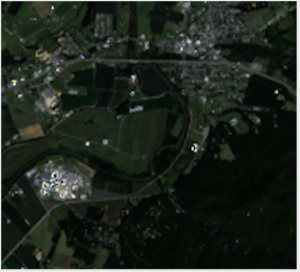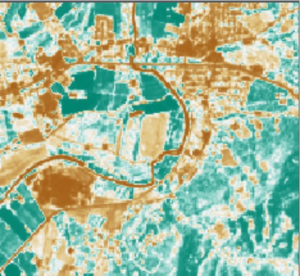除了DLA Ganos本身提供的UDF算子之外,您也可以通过自定义UDF来扩展DLA Ganos的功能,从而更加方便地与业务系统对接。
操作步骤
本文以计算归一化植被指数(NDVI)为例,来展示如何基于DLA Ganos实现用户自定义的UDF算子。
- 初始化SparkSession与DLA Ganos
implicit val spark = SparkSession .builder() .master("local[*]") .appName(getClass.getName) .withKryoSerialization .getOrCreate() .withGanosRaster import spark.implicits._ - 加载栅格数据图层
def readTiff(name: String) = SinglebandGeoTiff(IOUtils.toByteArray(getClass.getResourceAsStream(s"/$name"))) def redBand = readTiff("L8-B4-Elkton-VA.tiff").projectedRaster.toLayer("red_band") def nirBand = readTiff("L8-B5-Elkton-VA.tiff").projectedRaster.toLayer("nir_band") - 自定义UDF算子
val ndvi = udf((red: Tile, nir: Tile) => { val redd = red.convert(DoubleConstantNoDataCellType) val nird = nir.convert(DoubleConstantNoDataCellType) (nird - redd) / (nird + redd) }) - 计算NDVI并输出结果
val df = redBand.spatialJoin(nirBand).withColumn("ndvi", ndvi($"red_band", $"nir_band")).asLayer val pr = df.toRaster($"ndvi", 233, 214) val brownToGreen = ColorRamp( RGB(166, 97, 26), RGB(223, 194, 125), RGB(245, 245, 245), RGB(128, 205, 193), RGB(1, 133, 113) ).stops(128) val colors = ColorMap.fromQuantileBreaks(pr.tile.histogramDouble(), brownToGreen) pr.tile.color(colors).renderPng().write("ndvi.png")结果输出如下图所示:
